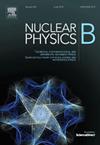Embedding class-I traversable wormhole in f(T,T) gravity via Karmarkar condition
IF 2.5
3区 物理与天体物理
Q2 PHYSICS, PARTICLES & FIELDS
引用次数: 0
Abstract
This article presents a traversable wormhole solution in extended teleparallel gravity, i.e., gravity showcasing the influence of prominent dark matter (DM) halos in such a structure by including energy densities of Universal Rotation Curve (URC), Navarro-Frenk-White (NFW), and Scalar Field Dark Matter (SFDM) DM profiles within the solution. In the first two sections following the introduction, the required field equations for a static, spherically symmetric Morris–Thorne spacetime with anisotropic fluid distribution have been derived in the backdrop of gravity. To get a glimpse of the wormhole visually, the Karmarkar's condition has been deployed while considering the redshift function as to obtain the shape function as a function of the radial coordinate only. This particular form of has been used to draw various 2D and 3D graphs through which all the necessary traversability conditions associated with a traversable wormhole model have been verified, and the wormhole structure has been visualized in 3D cylindrical coordinates through the embedding diagrams. The proper radial distance has also been evaluated and plotted graphically for this particular form of . After this, various properties of a typical wormhole in four separate configurations corresponding to energy density and the energy densities of three types of DM halos (URC, NFW, and SFDM) have been analyzed. In each configuration, the validity of four primary energy conditions (null, weak, dominant, strong) has been checked graphically, and it has been found that all four energy conditions break down at the wormhole throat. Next, the total amount of exotic matter about and around the wormhole throat has been deduced by calculating the averaged null energy condition through the volume integral quantifier. Lastly, the equilibrium of various forces within the wormhole model has been studied using the modified TOV equation.
求助全文
约1分钟内获得全文
求助全文
来源期刊

Nuclear Physics B
物理-物理:粒子与场物理
CiteScore
5.50
自引率
7.10%
发文量
302
审稿时长
1 months
期刊介绍:
Nuclear Physics B focuses on the domain of high energy physics, quantum field theory, statistical systems, and mathematical physics, and includes four main sections: high energy physics - phenomenology, high energy physics - theory, high energy physics - experiment, and quantum field theory, statistical systems, and mathematical physics. The emphasis is on original research papers (Frontiers Articles or Full Length Articles), but Review Articles are also welcome.
 求助内容:
求助内容: 应助结果提醒方式:
应助结果提醒方式:


